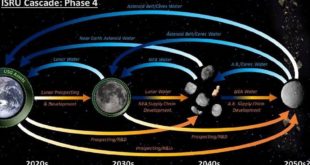Related Articles
Hunting for Water on Other Celestial Bodies: The Next Frontier in Space Exploration
From lunar ice to quantum sensors on Europa, water is becoming the ultimate key to life and exploration beyond Earth.
Why the Search for Water Matters
The modern space race is no longer just about exploration—it is also about resource utilization, with nations and private companies competing to stake their claims in space mining, colonization, and deep-space travel. Water is at the heart of this race, as it is essential for sustaining human life, producing oxygen, and generating fuel through hydrogen and oxygen separation. Lunar water deposits, particularly at the Moon’s poles, are seen as key to establishing permanent bases and refueling stations for missions to Mars and beyond.
Water is the foundation of life as we know it. Its presence on other celestial bodies not only raises the possibility of extraterrestrial life but also plays a crucial role in future human space exploration. Finding water could support sustained human missions beyond Earth, providing essential resources such as drinking water, oxygen, and even rocket fuel through electrolysis.
NASA and other space agencies have long followed the mantra: “Follow the Water.” This approach has led to remarkable discoveries, including evidence of liquid water beneath the icy crusts of moons like Europa and Enceladus. But detecting and confirming the presence of water, especially in subsurface oceans, remains a significant scientific challenge.
Similarly, water-rich asteroids and icy moons like Europa and Enceladus could serve as crucial supply points for long-duration space missions. The ability to locate, extract, and utilize water in space will define the future of interplanetary exploration and industry, making it one of the most valuable resources beyond Earth.
The Challenges of Detecting Water in Space
Despite its significance, detecting water on other planets and moons presents a formidable challenge. Water can exist in various states—liquid, ice, or vapor—depending on the environmental conditions of a celestial body. Identifying and confirming its presence requires sophisticated technology capable of distinguishing between these different forms, often hidden beneath layers of rock or ice.
One of the most significant obstacles is thick ice barriers. Many of the most promising locations for extraterrestrial water—such as Jupiter’s moon Europa, Saturn’s Enceladus, and Ganymede—are encased in kilometers-thick ice crusts that block direct observations. Drilling through these layers to access the hidden oceans below is a massive engineering challenge, requiring specialized landers, robotic drills, or melting probes capable of withstanding extreme conditions.
Beyond physical barriers, hostile environments pose another major difficulty. The deep-space conditions on these moons involve freezing temperatures, intense radiation, and low gravity, all of which complicate spacecraft landings and operations. Instruments must be designed to endure these extreme conditions while still functioning with high precision over extended periods.
Additionally, current remote sensing limitations hinder the search for subsurface water. Traditional tools like cameras and radar are excellent for mapping surface features, but they struggle to penetrate thick ice and provide detailed insights into underground water reserves. While indirect methods such as gravitational mapping and thermal imaging help infer the presence of liquid water, they lack the precision needed for definitive confirmation.
To overcome these challenges, scientists are turning to cutting-edge quantum technology. Recent breakthroughs in solid-state quantum magnetometry and advanced sensing techniques offer new ways to detect hidden water worlds. These innovations provide greater sensitivity, accuracy, and efficiency, bringing us closer than ever to unlocking the mysteries of subsurface oceans and their potential to harbor life.
NASA’s Breakthrough: Quantum Magnetometry
To overcome the challenges of detecting hidden water on distant celestial bodies, NASA scientists have pioneered quantum magnetometry, a revolutionary technique that allows for the detection of subsurface oceans by measuring variations in a planet or moon’s magnetic field. Unlike traditional methods that rely on optical or radar imaging, quantum magnetometry provides an indirect yet highly effective way to probe deep beneath icy surfaces. This breakthrough technology enables researchers to explore planetary interiors without the need for direct physical contact, making it an invaluable tool for space exploration.
How Does Magnetometry Work?
Magnetometry is a technique that measures changes in a celestial body’s magnetic field, which can reveal important information about its internal composition. Magnetic fields have the ability to penetrate solid materials, allowing scientists to gather data on hidden water layers that would otherwise be inaccessible.
- Europa and Ganymede: These moons of Jupiter are believed to harbor vast subsurface oceans beneath thick ice crusts. Jupiter’s strong magnetic field interacts with these oceans, inducing secondary magnetic fields. By analyzing these induced fields, scientists can infer crucial details about the presence, depth, and salinity of the hidden water layers.
- Enceladus: Saturn’s moon Enceladus has a known subsurface ocean, and similar magnetometry techniques help scientists determine if this ocean interacts with the moon’s rocky core. If such interactions are occurring, they could generate hydrothermal activity—a key factor in creating environments that may support microbial life.
The Role of Quantum Sensors
NASA’s development of solid-state quantum magnetometers represents a game-changing advancement in space exploration. These innovative instruments offer several advantages over traditional magnetometers, making them particularly well-suited for deep-space missions.
- Higher Sensitivity: Quantum sensors can detect extremely faint magnetic signals, allowing for more precise measurements of subsurface water layers. This increased sensitivity enhances the accuracy of water detection on distant celestial bodies.
- Smaller and Lighter: Traditional magnetometers are often large and bulky, requiring significant space and power resources. In contrast, quantum magnetometers are compact enough to fit on CubeSats and small planetary landers, enabling more cost-effective exploration.
- Self-Calibrating: One of the most significant advantages of quantum sensors is their ability to self-correct over time. Thanks to spin-nuclear quantum interactions, these devices automatically compensate for drift, improving long-term reliability.
- Lower Power Requirements: Space missions have strict power constraints, and energy efficiency is a crucial factor in instrument design. Quantum magnetometers consume far less power than traditional instruments, making them ideal for prolonged deep-space missions.
By integrating quantum magnetometry into upcoming planetary missions, NASA is revolutionizing how scientists study the hidden oceans of our solar system. This cutting-edge technology is not only expanding our understanding of distant worlds but also bringing us closer to answering one of humanity’s biggest questions—whether life exists beyond Earth.
Future Missions Using Quantum Magnetometers
NASA plans to deploy these advanced magnetometers on upcoming missions to Europa, Ganymede, and Enceladus. The Europa Clipper mission (set for launch in the 2030s) will carry a magnetometer to analyze the moon’s subsurface ocean. These technologies will also be instrumental in future lander and rover missions that will explore these ice-covered worlds up close.
The Bigger Picture: Water Beyond Our Solar System
While scientists are focused on nearby moons and planets, the search for water extends beyond our solar system. Researchers are now using quantum-enhanced spectroscopy and next-generation telescopes to detect water vapor in the atmospheres of exoplanets. The James Webb Space Telescope (JWST) has already identified water signatures in distant exoplanet atmospheres, offering promising clues about potentially habitable worlds.
Conclusion
The search for water beyond Earth is one of the most compelling quests in modern space exploration. From subsurface oceans on Europa and Enceladus to distant exoplanets with water-rich atmospheres, every discovery brings us closer to answering one of humanity’s greatest questions: Are we alone in the universe?
With quantum technology revolutionizing how we detect water, the next decade may bring groundbreaking discoveries—perhaps even evidence of life beyond Earth. As space agencies continue to push technological boundaries, one thing is clear: the future of space exploration flows where the water leads.
 International Defense Security & Technology Your trusted Source for News, Research and Analysis
International Defense Security & Technology Your trusted Source for News, Research and Analysis


